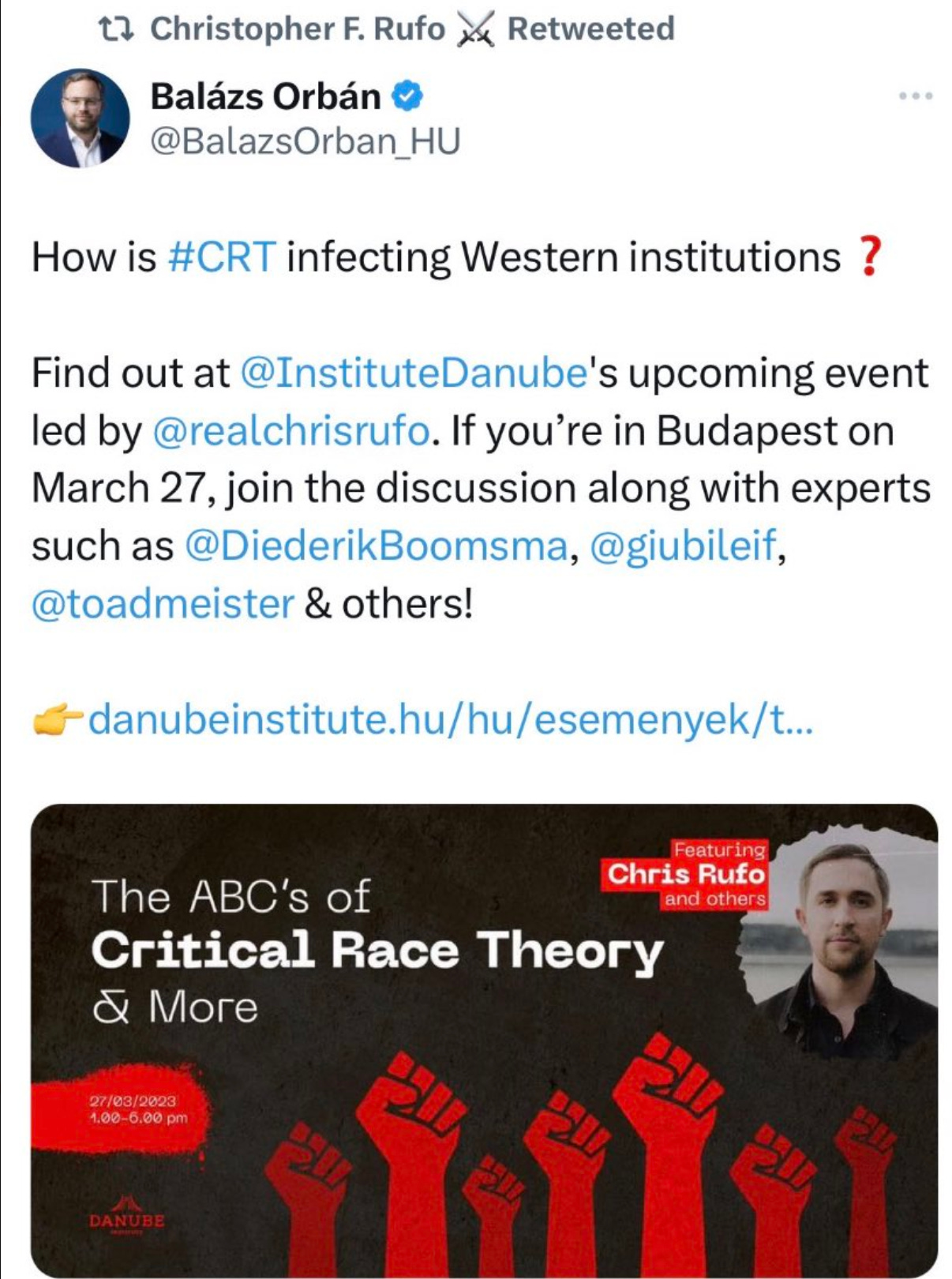Make America Hungary Again
MAGA's obsession with Orban reveals they want authoritarianism, not greatness
Donald Trump wrapped up his primary challenge, safe in the knowledge that the only other leader that might have given him a run for his money was ineligible to compete. That would be Viktor Orban of Hungary. Orban may not be a household name, but he is revered by the far-right elite. Why? Why does the Make America Great Again crowd want to follow the model of a third rate power?

Not only is Orban a frequent guest of CPAC, he has hosted CPAC in Hungary multiple times. Both Trump and the Heritage Foundation hosted and lauded Orban on his recent visit to the US. At Mar-A-Lago, Trump took the stage to declare: “There’s nobody that’s better, smarter or a better leader than Viktor Orban. He’s fantastic…He’s a non-controversial figure because he says ‘This is the way it’s going to be,’ and thats the end of it. Right? He’s the boss.” Orban, in return, gushed over Trump and said that Trump would immediately end Russia’s invasion of Ukraine, by abandoning the Ukranians.
An orderly model of Christian nationalist authoritarianism
What is the appeal of Orban? Hungary has a great history, but today it has a population of less than 10 million, which has been on the decline since the 1980s. Its per capita income is a fraction of the United States. Orban’s efforts to persuade Hungarian migrants to return have not turned the tide. Skilled young professionals with opportunities to work elsewhere are put off by Orban’s authoritarianism and anti-LGBTQ policies. The country is one of the biggest net recipients of EU aid.1
Part of the attraction to Orban is his policies: anti immigrant, anti EU (except for the money part), and embracing White Christian Nationalism. But these policies are not uncommon in Europe. So why is Orban feted in a way that Marine Le Pen of France, or Geert Wilders of the Netherlands, is not? The short answer lies in how Orban has implemented those policies. “He’s the boss” as Trump noted. Trump’s supporters see Orban as the type of President that Trump should have been, and might be yet: an authoritarian able to take control of government, bend it toward his ends, while erasing meaningful democratic checks.
To better understand the appeal of Orbanism, I asked some experts. My fellow McCourt Professor of Public Policy, Dan Keleman, is an expert on EU politics and law at Georgetown University. He offered that:
Orban's regime embodies what the American right hopes to achieve here in the US. Orban has dismantled Hungarian democracy and replaced it with "electoral autocracy" - a regime that maintains the trappings of democracy but which is in fact totally controlled by one leader and his party, which manipulates elections and abuses state resources to ensure it remains in power. They severely restrict press freedom and judicial independence, harass the opposition, and pursue a far-right agenda - persecuting migrants, the LGBTQ community, and other minorities.
Cas Mudde, Distinguished Research Professor at the University of Georgia, and one of the most far-sighted researchers of the far-right in Europe and beyond noted, offers a similar assessment
More than ideology or even particular policies, the US far right is trying to learn from Orbán how to stay in power for a very long time. They know he manipulates the system, which clearly is something they are comfortable with.
Orban was first Prime Minister between 1998 and 2002 before losing an election. He learned from his first term in office. When he returned to power, his Fidesz party rewrote the constitution and engaged in an incremental process of changing laws in a way that made it easier for him to accrue power, harder for him to lose it, and able to retain influence even if he loses at the ballot box. Unlike Trump, Orban was patient and disciplined in his use of state power.
A small example. For years, Orban officials offered bribes to nonresidents to register addresses in Hungary, and then vote at election time. The practice, known as voter tourism, was illegal. Until Obran legalized it in 2020. This is one of many ways that Orban has tilted the electoral playing field. Even when his party performs poorly, winning less than half the votes, they can still end up with legislative super majorities, thanks in part to a gerrymandered electoral formula that Orban devised.
Some more examples, from the justice system. Prior to Orban, an autonomous panel selected judges. Under Orban a party-aligned appointee has the final call, giving him firmer control of the judiciary. With this control, Orban changed the retirement age of judges, forcing many to retire. He also stacked the public prosecutors office with loyalists, making it much less likely he and his supporters will be investigated. This mirrors Trump’s plan to remove any independence from the Department of Justice.
In short, Orban employed the tried and tested strategy of authoritarians: take control of institutions in a way that stifled dissent. This included taking control of the press, the courts, the bureaucracy, and higher education. His appeal the American right is to be able to say “it can be done.”
Media control
According to the International Press Institute, Orban’s party now controls between 70-80 percent of the media. Much of this came via a 2018 consolidation of hundreds of media outlets under the ownership of a foundation controlled by his allies. A nine-member regulatory body, all Orban appointees, oversee the media. The media is then used to target political opponents. Orban’s opponents can’t buy political ads on state-controlled media, which run public service announcements that support Orban.
Andrew Higgins, the New York Times Bureau Chief for Central and Eastern Europe says:
Fidesz-controlled outlets treat critics as traitors and deviants. He has also funded a raft of friendly research institutes and a university that help flood the zone with pro-government views…Orban hailed Tucker Carlson as a model of how media should work: “There should be shows like his day and night — or, as you say, 24/7.” In Hungary, that goal has been achieved.
Having controlled internal debate, Orban moved to cut off any critical outside influence. A newly formed Office for the Defense of Sovereignty operates in tandem to the media control, threatening rival politicians with three years in jail if they are engaged in “subversive” actions by foreign actors, which is to say, if they are offered support from pro-democracy organizations. Foreign funds that go to non-governmental organizations or media could trigger prosecutions.
In this way, Orban mirrors Putin’s crackdown on non-governmental organizations in Russia. Indeed, Orban’s control of the media helps to explain how he is able to maintain his positive relations with Putin, a former KGB agent, in a country that was under Soviet control in living memory.
Using higher education to boost Orbanism
Even as Orban decries foreign influence, he has used state resources to strategically cultivate foreign relationships on the right, using higher education, think tanks and conferences to build his image. According to Cas Mudde:
Orbán “found” the US far right rather than the other way around. Since coming to power, but particularly since 2015, the Orbán regime has spent tens of millions buying the support of “conservatives”, mainly from the UK and US, in the hope that he would get closer to the heart of power of the Conservative Party and the Republican Party, respectively. As right-wing Americans enjoyed Orbán’s largesse, they started to promote Orbán and his regime in their outlets (e.g. Rod Dreher in The American Conservative) and through their organizations (e.g. CPAC).
Orban has made his US counterparts look like pikers in the agressive use of state power to shut down dissenting voices, ideas, and ultimately to move much of higher education from public to party control. Before there was discussion of CRT in the US, Orban banned gender studies. He controls top university appointments. He pushed public higher education institutions under the control of private foundations, run by his political cronies.
One foundation, Mathias Corvinus Collegium (MCC) was handed $1.7 billion in government money and asset to train conservatives and create programming for primary and secondary education. Even if Orban loses elections, his loyalists will remain. Advisory board members appointed by Orban were given lifetime positions, and they are the only ones who can select new members. This is a basic form of cronyism, a bribe to retain power. Orban appointed Balazs Orban (no relation), to lead the MCC even as he served as state secretary in the prime minister’s office.
The Lesser Orban serves as an ambassador to far-right academics and think tanks, such as the Heritage Foundation.
Here is the leader of Heritage welcoming Orban. Heritage is not just a fan of Orban’s authoritarianism, they have devised Project 2025, Trump’s own authoritarian roadmap.
Taking control of higher education both demonstrates to the foreign far-right Orban’s success in culture war issues, as well as offering opportunities to visit Hungary, and celebrate these successes.
Orban’s guests speak of the need to defend free speech in higher education even as they are being paid by an authoritarian to support and legitimate his censorship and imposition of state-determined speech in Hungarian higher education. They almost unfailingly characterize themselves as classical liberals, even as they favor what Orban himself has called an “illiberal democracy.” (The illiberal part is true, but its not really a democracy). These guests of the state include Niall Ferguson, Ilya Shapiro, Chris Rufo, Joshua Katz, Jordan Peterson, and Patrick Deneen

Some western right wing figures (such as Rod Dreher, and Chris Rufo) are paid by the Orban government via the Danube Institute, a chief vehicle of Orban’s efforts to connect to the far-right in the US and UK. The head of the Danube Institute, John O’ Sullivan, once worked at Heritage. Danube Institute contractors praise Orban and his government, without disclosing their financial interests, and potentially violating foreign lobbying laws.
The degree of hypocrisy can be astonishing. Peter Boghossian, a University of Austin professor moonlighting at the Danube Institute, declared during his visit: “It’s no longer liberal versus conservative. It’s become authoritarian versus anti-authoritarian. It’s become people like myself, who value the liberty of others, and the people who want to rob us of that liberty.” Or take this headline from Dreher.
Boghossian and Dreher might try to explain this to Michael Ignatieff. Ignatieff led the Central European University, which Orban forced to leave the country when they refused to bow to his control. CEU was internationally recognized and accredited by American institutions. Orban offered its campus to Fudan University from China, an institution more comfortable with government control. Ignatieff explained the appeal of targeting higher education for authoritarians, drawing parallels to Trump:
attacking colleges and universities also mobilizes the resentments of people who never went to a university and may dislike, often justly, the entitlement that a college degree can confer on its beneficiaries. If a crucial component of the Trump-era Republican electorate comprises people who may not have graduated from high school, then an attack on universities is pure gravy for the demagogue. Similarly, for these angry voters, the downside of such an attack—weakening the scientific, technical, and cultural innovation that universities make possible—does not carry much weight…These attacks on university autonomy and academic freedom—in U.S. states, in Narendra Modi’s India, and in Erdoğan’s Turkey—are principally about one thing: systematically weakening any institution that may act as an obstacle to authoritarian power. Although American conservatives, no less than their autocratic counterparts abroad, consistently portray their attacks on universities in pseudo-democratic terms—as attempts to protect the silent majority from the ideological hectoring of the liberal elite—their real agenda is to weaken democratic checks and balances.
Corrupting the bureaucracy to enable a mafia state
A consistent pattern in Orban’s model of governing is to take control of independent institutions, to stifle dissent, but also to create patronage opportunities for loyalists. Both higher education and much of the media were pushed into private foundations created by Orban and run by his allies. Orban has done the same with other parts of the state bureaucracy. The cronyism creates more stakeholders whose financial interests are tied to Orban’s political interests. And because political allies have taken control of the judicial system, this corruption is harder to fight. Writing in The Atlantic, Franklin Foer warns that the promise of Orban is not just authoritarianism but of corruption, a “mafia state”:
At the center of Orbán’s Mafia state is a system of patronage. When he finally won consolidated control of the government in 2010, he purged the nation’s civil service—a “bloodless liquidation”…In place of professionals and experts, Orbán installed party loyalists. This wasn’t a superficial shuffling of his cabinet, but a comprehensive remaking of the nation’s public sphere. It is testimony to the thoroughness of his conquest that his apparatchiks took control of the Hungarian Chess Federation and a state-funded project to develop dental tourism. The party loyalists Orbán appointed became the capos of his crime family. Their job was to reward its friends (by sharing the spoils of government contracts) and to punish its vocal critics (with tax audits and denial of employment).
Orban’s corruption of public services is such an open fact of Hungarian life that the US Ambassador to Hungary, David Pressman called out Orban for ensuring that “all aspects of government power – from procurement, to licensing, to tourism subsidies, to concessions, to tax and audit actions, to regulatory policy – provide favorable treatment for companies owned by party leaders or their families, in-laws, or old friends.” None of this seems to put off Orban’s right-wing fan club in the US. Indeed, they have embraced Trump’s Schedule F plan, which will him the tools to follow in Orban’s footsteps. Will civil servants who Trump can easily replace be able to fend off a wave of corruption?
What will American Orbanism look like?
American Orbanism will look different from the original. Trump is not Orban, and it remains to be seen if he can rein in his chaotic approach to leadership. On the other hand, he will have a more capable and loyal team than before who, like Orban, have learned from his first term.
Hungary is also different from the US. From Cas Mudde:
As I have laid out in more detail in an article last year, it will not be so easy to copy Orbán’s power takeover in the US, not so much because Americans are allegedly "more democratic”, but because there are fundamental differences in political systems. Hungary has one of the simplest political systems to control, with a highly disproportional electoral system, a mono-cameral legislature, and a unitary state. As a consequence, there are very few so-called “veto players” once a party holds a parliamentary majority. Orbán has used a rather fortunate election victory in 2010 to quickly, and very smartly, transform the political system in a largely legal manner. The US system is almost completely the opposite, with the exception of a very disproportionate electoral system. The US has very strong federalism, limiting the “national” power, and a symmetric bicameral legislature, requiring majorities (or more) in both chambers to pass legislation. Most importantly, it is extremely difficult to change the constitution, something requiring just a two-third majority in the one chamber of parliament in Hungary.
State media plays less of a role in the US, and first amendment protections make it harder for the government to take control. In any case, Republicans already have their own robust party media ready to push propaganda. Judicial appointments are already highly politicized, and Trump benefits from a super-majority on the court. Nonetheless, there are worrying trends, and with a sufficient will, American Orbanists will find ways to extend Trump’s power. My Georgetown colleague Dan Keleman:
The American right hopes to learn the elected autocrat's playbook from Orban - the set of steps an aspiring autocrat needs to translate an election victory into a permanent hold on power. Trump failed to achieve this last time, and American institutions proved resilient. This time around Trump wants to follow Orban's model in tightening his grip over the judiciary and media, eliminating independent institutions, using control of state offices to persecute political opponents, and quickly cementing his grip on power.
The key lessons for American Orbanists, according to Mudde, is less about specific tactics, and more about the general strategy for amassing control:
(1) you can fundamentally change a political system from within;
(2) sequencing is crucial in changing the system legally, i.e. by staying within the narrow borders of the law; and
(3) most of your voters don’t really care about the rights of “the Other” (i.e. ethnic, religious, but also political opponents) as long as you give them what they want — or at least the feeling that you do or try to do so — from tax breaks to fences at the Southern border.
In some areas, these lessons are already being applied. American politicians are explicit about using Orban-like strategies to take control of higher education. Senator JD Vance recently said:
You know, the closest that conservatives have ever gotten to successfully dealing with left-wing domination of universities is Viktor Orbán’s approach in Hungary. I think his way has to be the model for us: not to eliminate universities, but to give the a choice between survival or taking a much less biased approach to teaching…And whether it’s the incentives that you put into place, funding decisions that are made, and the curricula that are developed, you really can use politics to influence culture. And we should be doing more of that on the American Right.
Universities in red states (or purple states corrupted by gerrymandering) are already seeing education political appointees who call for firing liberals, censoring speech around gender and race, reducing faculty and student influence on campus governance, and embedding conservative institutions within universities. If Trump returns to office, he will use federal power to punish all higher education institutions, including private ones, that stray from MAGA orthodoxy on topics like DEI. Such efforts have benefited from liberals that have gone along with free speech, wokeness, or viewpoint diversity narratives. But at some point they must realize that Orbanism is the end goal of the right’s attack on higher education: an authoritarian party capable of shutting down any independent sources of dissent. As Michael Ignatieff, the CEU leader, noted from his experience in Hungary:
Liberals should defend academic freedom not as the privilege of a profession, nor to preserve universities as bastions of progressive opinion, but because universities—like courts, a free press, and independent regulatory bodies—are essential restraints on majoritarian rule that keep us all free.
There is currently a fight within the EU about whether it should release funds to Hungary: the Parliament says that Hungary has failed to meet democratic milestones like an independent judiciary, but the Commission is willing to release funds, seemingly as long as Orban tempers his anti-Ukraine positions.







Great article. Thanks.
Paul Krugman should get credit for warning about Orban from early on. Personal acquaintance, I think.
Reining in Orban probably depends on Europe. Orban's Hungary doesn't belong in the EU. Can the EU rise to the challenge?
While I knew overall what Orban was up to, this explanation was thorough and important. I think many people are waking up to the reality that the fight against authoritarianism is constant.